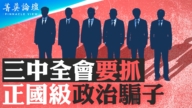【新唐人2011年12月1日訊】今年以來,中國藏區頻頻發生僧尼和佛教徒自焚事件。學者認為,中共消滅宗教的政策從來沒有改變,導致衝突不斷。而中共與阿壩地區藏人的衝突由來已久,涉及三代人。中共的所謂「反分裂」政策,對僧人的嚴格限制也是導致民族抗爭不斷的主要原因之一。
四川阿壩地區甘丹曲林寺的35歲藏族尼姑班丹曲措,為抗議中共當局對藏區的嚴厲管制,11月3號自焚死亡,她是自今年3月16號,阿壩格爾登寺20歲僧人平措自焚之後,第11個自焚的佛教徒,也是死亡的第6人。
旅美西藏近代史學者李江琳通過研究發現,阿壩地區藏人與中共的衝突由來已久,涉及三代人。而僧人以死抗爭是因為阿壩州對僧人的限制極其嚴苛。
以發生首例僧人自焚事件的格爾登寺為例,中共當局強制格爾登寺必須遵守的條例就有356條之多,這還不包括相關法規和各縣的「土政策」和許多不公開的「紅頭文件」,另外,還設有群眾監督評議委員會、寺管會等,僧人的一舉一動都在層層監督之下。
出家的僧人不但無法學經,還要被迫接受「愛國主義教育」、詆毀他們的上師,他們內心非常痛苦和憤怒。
李江琳從紅軍將領們的回憶錄中發現,藏人與紅軍進行了很多次戰鬥,所以第一代仇恨從那時就開始了。
李江琳:「第一代是紅軍時期,紅軍路過川西北地方,長征時間的三分之二是在四川就是在藏區度過的,其中主要是在阿壩和嘉絨地區。他們大量搶奪藏民的糧食,而且他們住在格爾登寺的大殿裡,在它們的壁畫上寫標語。」
阿壩藏族自治州是四川省的第二大藏區,格爾登寺是當地規模最大的藏傳佛教寺院,西元1412年創建。而中共篡政後,格爾登寺一度被摧毀。中共的戰爭造就了第二代仇恨。
李江琳:「56年到62年,在那一代發生了戰爭。特別是後來1958年的『四反運動』,寺院幾乎全部關閉,絕大多數關閉。格爾登寺從1958年逐漸的被摧毀,到了文革期間,除了兩三間房子以外變成了一座荒地,完全沒有了。」
那時青海、四川、西藏所有的寺院,包括漢區也都一樣,寺院被大量的摧毀。現在的格爾登寺是80年代胡耀邦執政期間重建的。
民族幹部楊嶺多吉從1980到1985年在西藏擔任自治區領導。他認為,胡耀邦、趙紫陽主政時代是實現民族和解的最好時期,那段時間關係緩和,藏區也比較平靜,但89年之後民族政策大逆轉,矛盾日漸激化。
對於近期藏人連續以自焚抗爭,有西藏學者認為,這是中共的新殖民主義、種族滅絕政策導致的。李江琳認為,連續的自焚、絕不是誰能指使的。應該讓國際媒體做獨立調查,讓當地藏人說話。
不過,中共聲稱,在中國,宗教是自由的。
對此,李江琳表示,中共從50年代一直到現在,從未隱瞞最終消滅宗教的主張,也不諱言「宗教自由」只是一個策略。她質疑:在執政黨以促進宗教消亡為指導思想的國家裏,能允許宗教自由存在嗎?
新唐人記者周玉林、宋風、孫寧採訪報導。
When Will Tibetan Self-Immolations End?
This year, China has witnessed a rash of self-immolations
of Tibetan Buddhist monks and nuns.
Scholars say that the Chinese Communists Party (CCP)
has never changed its policy towards religions, which has fueled one conflict after another.
The conflict between the CCP and Aba-based Tibetans
has a long history.
The CCP’s so-called “anti-secession" policy,
which has put severe restrictions on Tibetan Monks, is one of the main reasons behind these endless protests.
Palden Choetso, a 35-year-old Tibetan nun, self-immolated
on November 3 in Aba Prefecture, Sichuan Province,
China to protest the CCP’s strict control over
the Tibetan region.
Palden was the 11th. self-immolation and the sixth death
since 20 year-old monk, Phuntsog’s self-immolation related death this March.
According to a study conducted by Li Jianglin,
a U.S.-based scholar on Tibetan modern history,
Aba-based Tibetans have been fighting against the CCP
for three generations.
The Monks’ idea of defending their country to the death is
due to the extremely harsh restrictions placed on the Monks there, by the CCP Aba authorities.
For example, the first monk to self-immolate resided in the
Geer Deng Monastery,
which is harshly governed by 356 mandatory regulations
stipulated by the CCP authorities.
Besides that, there are relevant laws, regulations,
and local policies of various counties and lots of secret official documents to abide by and follow.
The authorities also set up the Mass Supervision and
Appraisal Committee, the Temple Management Committee,
and other agencies,
to put local Buddhists under constant surveillance.
Monks and nuns are not only prevented from studying scriptures,
but are also forced to and to slander their guru and accept the CCP』s official “patriotic education."
which causes them a lot of pain and makes them furious.
Li Jianglin found that the Red Army generals’ memoirs
mentioned many wars between the Tibetans and the Red Army.
It was at that time that the seeds of hatred were sown in the
hearts of the first generation of Tibetans.
Li Jianglin: “The first generation of hatred took place
during the Red Army era, when the Red Army passed through the northwestern part of Sichuan Province.
Two-thirds of the Long March was spent in the Tibetan areas
of Sichuan Province, mainly at Aba and Gyalrong regions.
The troops stole large amounts of food from the Tibetans.
When the CCP troops occupied the Geer Deng Temple Hall,
they even wrote CCP slogans on the murals."
The Aba Tibetan Autonomous Prefecture is the second largest
Tibetan-inhabited area in Sichuan Province.
The Geer Deng Temple is the largest local Tibetan Buddhist
temple, founded in 1412 AD.
The Geer Deng Temple was destroyed after the
CCP came to power.
The CCP‘s internal wars generated a second generation of hatred.
Li Jianglin: “From 1956 to 1962, a war took place in that area,
especially after the CCP’s Four-Anti Movements were initiated in 1958,
which saw the closure of almost every monastery.
Since 1958, the Geer Deng Temple was gradually destroyed.
During the Cultural Revolution, there were only two or
three houses left standing and the surrounding area looked like a wasteland."
At that time, all the monasteries in Qinghai and Sichuan
Province and Tibet, as well as in other regions of China, were destroyed.
The current Geer Deng Temple was reconstructed
during the reign of Hu Yaobang, in the 1980s.
Yang Ling Dorje, a former senior Tibetan cadre said that
the period between 1980-1985, which was during
the reign of Hu Yaobang and Zhao Ziyang, was the best period,
which helped foster national reconciliation.
At that time, relationships between the different nationalities
eased, and the Tibetan-inhabited areas were relatively calm.
However, after 1989, the nationality policy went into reverse,
and conflicts among the different nationalities dramatically increased and intensified.
Tibetan scholars often comment on the ongoing Tibetan
self-immolations, saying that
that was due to the CCP’s implementation of
its new colonialism and genocide policy.
Li Jianglin believes that the ongoing self-immolation incidents
are absolutely unable to be pointed by anyone.
She proposes that the international media should conduct
independent investigations, helping local Tibetans to speak out.
However, the CCP authorities have the insane audacity
to claim that China enjoys freedom of religion.
In response to the CCP’s claim, Li Jianglin said that
since the 1950s the CCP authorities have never tried to conceal
their intention of ultimately eliminating religions,
nor did they avoid mentioning the term “religious freedom,"
which was just a propaganda tactic.
Jianglin asks the question: if the ruling party of a country
is dead set on eliminating religions as its guiding ideology, how can religious freedom really exist?
NTD reporters Zhou Yulin, Song Feng and Sun Ning.



















